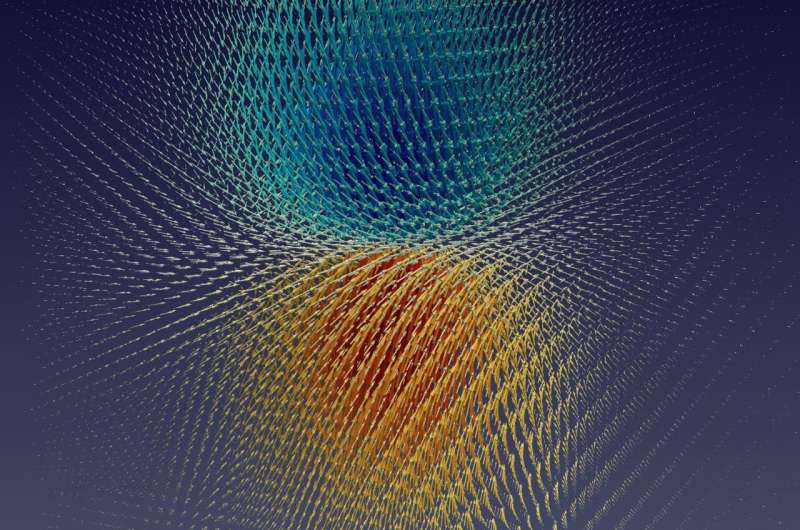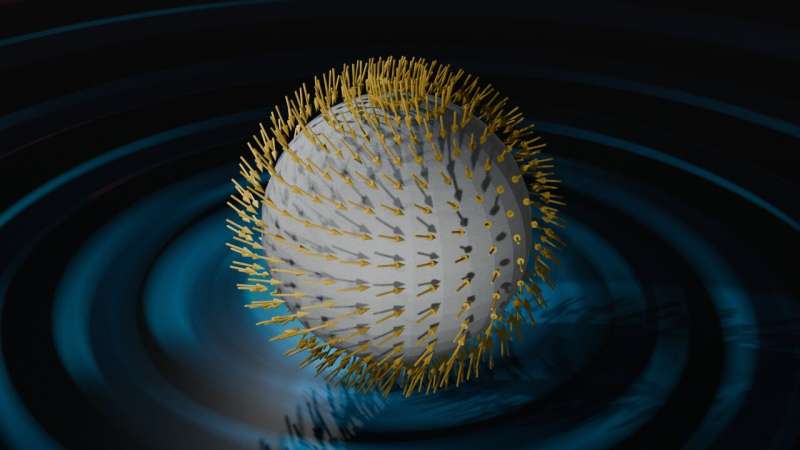June 14, 2024 feature
This article has been reviewed according to Science X's editorial process and policies. Editors have highlighted the following attributes while ensuring the content's credibility:
fact-checked
peer-reviewed publication
trusted source
proofread
Exploring the origin of polaron formation in halide perovskites

Halide perovskites are a class of materials with an underlying structure resembling that of mineral perovskites, but with X sites occupied by halide ions, while their A and B sites are occupied by cations. These materials have various advantageous properties that make them promising candidates for the development of photovoltaics (PVs), light-emitting diodes (LEDs) and other optoelectronic devices.
Recent studies have gathered interesting insight about halide perovskites and their optoelectronic properties. Nonetheless, the origin of these materials' remarkable carrier lifetimes has not yet been uncovered.
Researchers at the University of Texas at Austin recently carried out a study aimed at shedding new light on the origin of these extraordinary carrier lifetimes. Their paper, published in PNAS, shows that halide perovskites are governed by unconventional electron-phonon physics, which results in the formation of a new class of quasiparticles that the authors dubbed "topological polarons."
"Our motivation was of an experimental nature," Jon Lafuente, Chao Lian, and Feliciano Giustino, co-authors of the paper, told Phys.org.
"Halide perovskites are extraordinary materials for applications in photovoltaics and light-emitting devices due to their exceptional optoelectronic properties, such as long carrier lifetimes and diffusion lengths. Some of the most advanced experimental techniques have been applied to these materials to shed light into the origin of these unusual properties and to clarify the origin of their extraordinary energy conversion efficiency."
Evidence gathered in recent experiments suggest that strong interactions between electrons and vibrations in the atomic lattice of halide perovskites could contribute to their remarkable carrier lifetimes and power conversion efficiencies. Specifically, some researchers have suggested that the key process underpinning these properties could be the formation of polarons, localized quasiparticles comprised of electrons coupled to distortions of the crystal lattice.
"The lack of appropriate theoretical methodologies that incorporate the full complexity of these materials and these quasiparticles has so far hindered our ability to understand the formation of polarons in halide perovskites at the atomic scale," Lafuente and Giustino explained.
"Our group had recently developed a novel high-performance computing approach to study the formation of polarons incorporating the interaction between the electronic carriers and lattice vibrations, starting from the first principles of quantum mechanics."
Over the past few years, Lafuente, Lian, Giustino and their colleagues have been trying to facilitate the implementation of their proposed methodology using highly-performing codes, which they could then run on some of the world's largest supercomputers (i.e., the TACC and NERSC computers). As part of their recent study, they specifically set out to use these methods to study the formation of polarons in halide perovskites.

"With these methods, we were able to consider simulation cells ranging from several tens to almost half a million atoms, which has never been achieved before," Lafuente and Giustino said.
"Our calculations led to several unexpected results. Firstly, we found that polarons can take many different forms in halide perovskites; they can be very large, spanning several nanometers in length, or they can be very small, localizing around a single bismuth atom."
The simulations run by Lafuente also revealed that polarons in halide perovskites can even form periodic distortions, manifesting at high enough densities as charge-density waves. Notably, the various types of polarons they observed in their simulations appeared to form at different timescales.
"For example, we predict that upon illumination, first large polarons will form and then these will transform into small polarons," Lafuente and Giustino said.
"Our predictions agree remarkably well with available ultrafast pump-probe spectroscopy experiments. Perhaps the most surprising discovery, however, is that polarons in halide perovskites come with a 'twist'; the atomic displacements surrounding the polarons form vortex patterns, and the associated vector fields have well defined topology which can be described by quantized topological numbers."
The topological structures unveiled by the researchers were found to be strikingly similar to those of skyrmions, merons and Bloch points—three types of intriguing quasiparticles previously observed in magnetic systems. The existence of non-magnetic polarons with characteristics resembling those of magnetic quasiparticles had never been reported before, thus this study could open new avenues for future investigations, potentially leading to exciting discoveries.
"There are two main directions that we are now eager to pursue," Lafuente and Giustino said. "On the one hand, even if these results paint a detailed atomic-scale picture of polarons in halide perovskites, they do not tell us exactly how these quasiparticles interact with light or how they propagate across the material. We would like to develop methods to predict transport and optical properties of these polarons in more detail."
By developing new approaches to predict the optical properties of polarons in halide perovskites, the researchers hope to reliably predict new physical phenomena and explain their origin. Concurrently, they plan to explore the extent to which their findings can be generalized across different materials.
"Are topological polarons unique to halide perovskites, or can they also form in other materials?" Lafuente and Giustino added.
"What are the main physical ingredients needed for the formation of topological polarons? Can we tune material parameters, e.g. via strain, chemical composition or light, to tweak the topological charge and helicity of polarons?
"These are some of the bigger questions that we will try to answer in the future. Ultimately, the discovery of topological polarons may open entirely new avenues in the manipulation of quantum information via novel non-classical degrees of freedom."
More information: Jon Lafuente-Bartolome et al, Topological polarons in halide perovskites, Proceedings of the National Academy of Sciences (2024). DOI: 10.1073/pnas.2318151121
Journal information: Proceedings of the National Academy of Sciences
© 2024 Science X Network





















